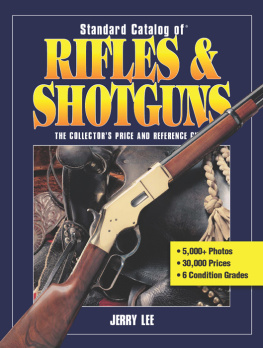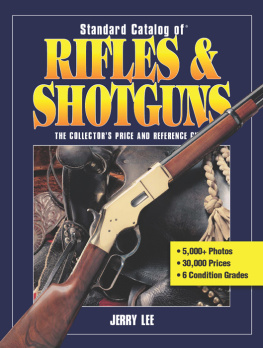Thank you for purchasing this Gun Digest eBook.
Sign up for our newsletter and receive special offers, access to free content, and information on the latest new releases and must-have firearms resources! Plus, receive a coupon code to use on your first purchase from GunDigestStore.com for signing up.
or visit us online to sign up at
http://gundigest.com/ebook-promo
CONTENTS
DIRECTORY
INTRODUCTION TO THE 8TH EDITION
Thank you for picking up your copy of Standard Catalog of Military Firearms, 8thEdition. This is my fifth time as the author and compiler of this title. This type of book is generically referred to as a price guide since there is a value is assigned to each listing in order to inform the reader of how much they might pay if they want to own such an item. Or, the guide will come in handy if they have one to sell and are looking for an idea on how much they might be able to get for their property. By informing people on both sides of a transaction of a general price range, this guide becomes a useful tool to encourage the historical firearms collector, or just for good old-fashioned gun trading. Most military firearms found for sale are not sold to true collectors. The serious collectors are the guys that only want mint, matching specimens that are rarely available outside the high-end auctions. The average buyer of the type of guns found here is not a serious collector, but just a person with a desire to own and shoot a variety of pieces of history.
My main contribution to this title has been the listings with values for bayonets, magazines and holsters. The bayonets were added to the 4th Edition, the magazines were in the 5th, holsters and pre-cartridge military rifles appeared the 6th Edition. These related item listings are what set Standard Catalog of Military Firearms, 8thEdition apart from other firearm price guides. There have been a few other books published that focus on bayonets or holsters, but they rarely include a pricing component. Most publishers of the information-only books will state that pricing trends change and so including it dates their book, which could potentially harm their buyers if they use a guide that is years out of date. A valid point but my theory has been that some basic pricing information always helps those readers who are not experts or advanced collectors. Yes, market values usually seem to trend higher, but the change in price for vintage collectible accessories is small compared to the complete firearm. The accessories listed here are just examples of items commonly associated with the guns they fit. There is not enough room to give expanded coverage showing all of the different variations and markings.
There is no other price guide or reference book that lists magazines used in specific firearms. The magazine is a critical part of a complete firearm, and original examples can be scarcer than the guns they fit. I see a lot of vintage handguns being sold with modern replacement magazines in them. That is fine if the buyer is only interested in getting a functional gun, but the missing factory magazine can count for $25 to $200 in the value of the gun. Some early Colt or Luger magazines can go up to $500!
There are not a lot of new old guns to add to the catalog. For the 8th Edition I have added more than 50 images to new or existing firearms and accessory listings. These include several new holsters or magazines, as well as better images that replace old and dark pictures that were originally in the book before the 4th Edition, or they show items or markings found in the listings that were not shown previously.
Notable new listings and images in this edition include the Canadian #5 .22 trainer, French MR-73 revolver, French MAS 1949 sniper rifle, English Webley Mk 4 War Finish and Mk 6 revolvers, Netherlands Steyr M1895 .303 carbine, Russian 1895 Nagant Target revolver, Makarov pistol, Mosin-Nagant 91/59, Spanish Mauser 1893 carbine and Yugoslavian Model 57 pistol.
Other new listings and images include scarce bayonets such as the Italian M1870 Vetterli and Carcano Troop Special, rare holsters like the Hungarian Frommer Stop, JP Sauer M1913, and a German World War I era 7,65mm auto pistol, as well as a Russian 1895 Nagant and Makarov pistol. Finally, there are a dozen new magazine images with a price range included.
All of the new photographs were taken by me, as these items passed through my business of dealing with historical military weaponry and associated items. This is a one-man operation, until I hand the manuscript to the publisher. Many of the changes and revisions have been due to suggestions from readers of earlier editions, and I do read a few of the online reviews to get a bit of feedback on how people are using this guide. I am pleased to hear that most reviewers find Standard Catalog of Military Firearms to be informative and helpful.
Phillip Peterson
0771 S 500 E
BASIC MAGAZINE NOMENCLATURE

Here are some details to observe when examining a magazine:
- The shape of the follower and feed lips.
- The number and placement of holes or slots in the magazine body.
- The shape of the floor plate and how it is attached to the magazine body.
- Blued, phosphate, nickel, or a combination? Some original magazines have a different finish than the gun they came with.
- Condition. Look for dents in the body that might interfere with filling it, or inserting it in the gun, and for damage to the locking slot. Also check the feed lips for any bends or cracks.
- Markings. Many original issue magazines have no markings. Some military issue magazines have added markings that are not present on identical commercial examples.
BASIC BAYONET NOMENCLATURE

BLADE BAYONET

SOCKET BAYONET
MARKET TRENDS
The 2016 presidential election is history as you read this. The gun control topic was used many times by all candidates involved. Overall, the U.S. retail market for firearms continues to BOOM (sorry). But, the collector market remains soft in comparison to sales of new handguns and modern sporting rifles. Curio and relic firearms have not experienced the panic-driven price increases that new guns have.
Many new gun buyers simply have not yet developed an interest in vintage guns, and their limited budget prevents the entry level buying that millions of older gun owners have done since 1986. Back then, when there were numerous rifles and pistols available for under $100, lots of young gun owners could afford to develop an interest in military firearms. These days, most of their fun money is going for new guns that many fear could be removed from the market at any time. The curio and relic firearms are not under any threat so no panic buying takes place.


















